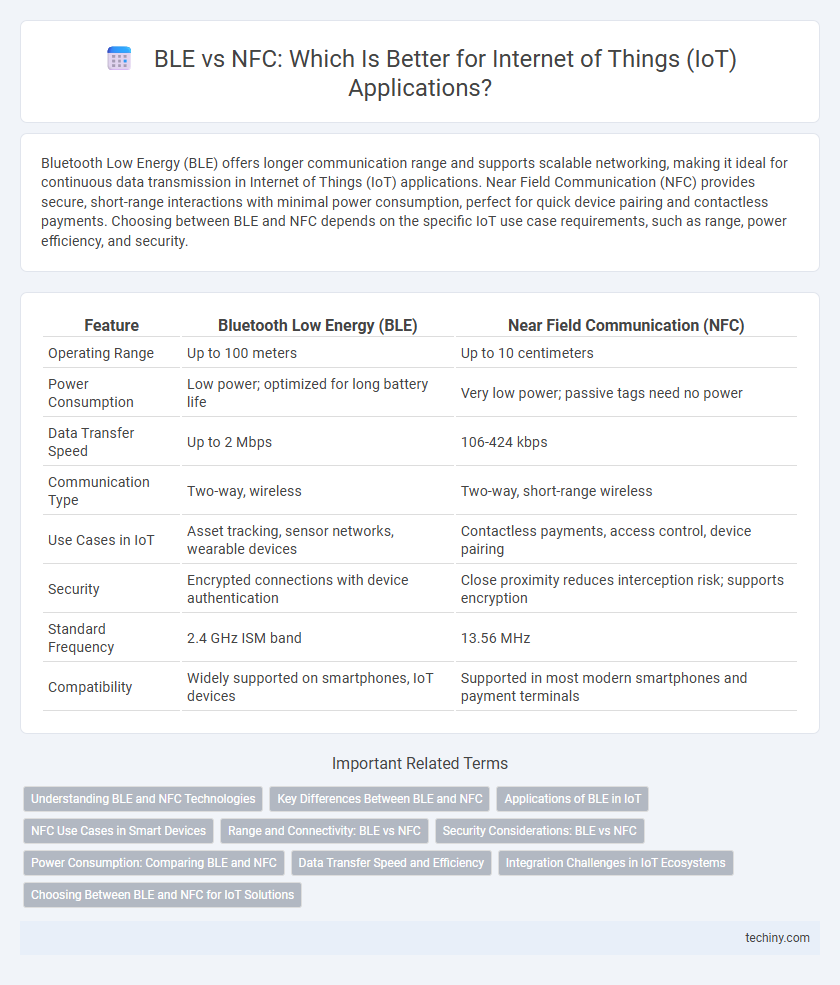Bluetooth Low Energy (BLE) offers longer communication range and supports scalable networking, making it ideal for continuous data transmission in Internet of Things (IoT) applications. Near Field Communication (NFC) provides secure, short-range interactions with minimal power consumption, perfect for quick device pairing and contactless payments. Choosing between BLE and NFC depends on the specific IoT use case requirements, such as range, power efficiency, and security.
Table of Comparison
| Feature | Bluetooth Low Energy (BLE) | Near Field Communication (NFC) |
|---|---|---|
| Operating Range | Up to 100 meters | Up to 10 centimeters |
| Power Consumption | Low power; optimized for long battery life | Very low power; passive tags need no power |
| Data Transfer Speed | Up to 2 Mbps | 106-424 kbps |
| Communication Type | Two-way, wireless | Two-way, short-range wireless |
| Use Cases in IoT | Asset tracking, sensor networks, wearable devices | Contactless payments, access control, device pairing |
| Security | Encrypted connections with device authentication | Close proximity reduces interception risk; supports encryption |
| Standard Frequency | 2.4 GHz ISM band | 13.56 MHz |
| Compatibility | Widely supported on smartphones, IoT devices | Supported in most modern smartphones and payment terminals |
Understanding BLE and NFC Technologies
BLE (Bluetooth Low Energy) and NFC (Near Field Communication) are wireless communication technologies commonly used in the Internet of Things (IoT) for device connectivity and data exchange. BLE offers low power consumption and longer communication range, making it ideal for continuous monitoring and data transfer in smart home devices, wearables, and asset tracking. NFC enables secure, short-range communication with simple tap interactions, primarily used in contactless payments, access control, and device pairing within a few centimeters.
Key Differences Between BLE and NFC
Bluetooth Low Energy (BLE) provides long-range wireless communication up to 100 meters with low power consumption, making it ideal for continuous data exchange in Internet of Things (IoT) devices. Near Field Communication (NFC) operates within a very short range of approximately 4 centimeters, enabling secure, quick data transfer and contactless payment applications with minimal energy use. BLE supports complex device-to-cloud connectivity and mesh networking, while NFC is primarily used for simple, point-to-point communication and device pairing in IoT ecosystems.
Applications of BLE in IoT
Bluetooth Low Energy (BLE) plays a crucial role in IoT applications by enabling energy-efficient wireless communication for devices like smart home systems, wearable health monitors, and asset tracking solutions. BLE supports long battery life and reliable data transmission, making it ideal for continuous monitoring and real-time updates in smart cities and industrial automation. Its widespread adoption in proximity sensing and device interconnectivity enhances user experiences across consumer electronics and healthcare sectors.
NFC Use Cases in Smart Devices
Near Field Communication (NFC) enables seamless, short-range wireless interactions in smart devices, ideal for contactless payments, access control, and device pairing. NFC's secure data exchange and ease of use make it a preferred choice for applications requiring quick, tap-based connectivity without complex setup. In smart home systems, NFC enhances user experience by facilitating effortless authentication and automation triggers, supporting efficient and intuitive device management.
Range and Connectivity: BLE vs NFC
Bluetooth Low Energy (BLE) offers a significantly longer range, typically up to 100 meters, enabling seamless connectivity for IoT devices across large areas. Near Field Communication (NFC) operates within a very short range, usually less than 10 centimeters, providing secure and instantaneous connection ideal for close-proximity interactions. BLE supports continuous data exchange with multiple devices simultaneously, while NFC is designed for quick, single-connection setups without pairing requirements.
Security Considerations: BLE vs NFC
Bluetooth Low Energy (BLE) and Near Field Communication (NFC) offer distinct security models in the Internet of Things (IoT) ecosystem. BLE provides longer-range communication but is more vulnerable to eavesdropping and man-in-the-middle attacks if encryption and authentication are not properly implemented. NFC, operating at very short ranges (typically under 10 cm), inherently reduces interception risks and supports secure element integration, making it generally more resistant to unauthorized access in IoT applications requiring stringent security.
Power Consumption: Comparing BLE and NFC
Bluetooth Low Energy (BLE) consumes more power than Near Field Communication (NFC) due to its continuous wireless connectivity and longer range capabilities. NFC operates with ultra-low power by establishing communication only within a few centimeters, activating power only during active data exchange. For IoT devices prioritizing minimal energy usage and short-range communication, NFC offers significant advantages over BLE in power efficiency.
Data Transfer Speed and Efficiency
Bluetooth Low Energy (BLE) offers faster data transfer speeds, typically up to 2 Mbps, compared to Near Field Communication (NFC), which operates at speeds up to 424 kbps. BLE's efficiency in maintaining connections over longer distances, up to 100 meters, enables continuous data exchange with lower power consumption. NFC excels in secure, instant communication within a few centimeters, making it ideal for quick, low-bandwidth exchanges like contactless payments or device pairing.
Integration Challenges in IoT Ecosystems
BLE and NFC face distinct integration challenges in IoT ecosystems, with BLE requiring robust management of complex network topologies and energy-efficient protocols to support continuous device connectivity. NFC integration struggles with limited communication range and slower data transfer rates, complicating seamless interaction among diverse IoT objects. Both technologies demand adaptive firmware and secure data exchange mechanisms to ensure interoperability and resilience within heterogeneous IoT environments.
Choosing Between BLE and NFC for IoT Solutions
BLE (Bluetooth Low Energy) offers extended range and low power consumption, making it ideal for continuous device monitoring and data transmission in IoT environments. NFC (Near Field Communication) operates within a very short range, providing secure, instant communication suited for contactless payments and device pairing in IoT applications. Selecting between BLE and NFC depends on factors like required communication distance, security needs, power constraints, and the specific use case within the IoT ecosystem.
BLE vs NFC Infographic

 techiny.com
techiny.com